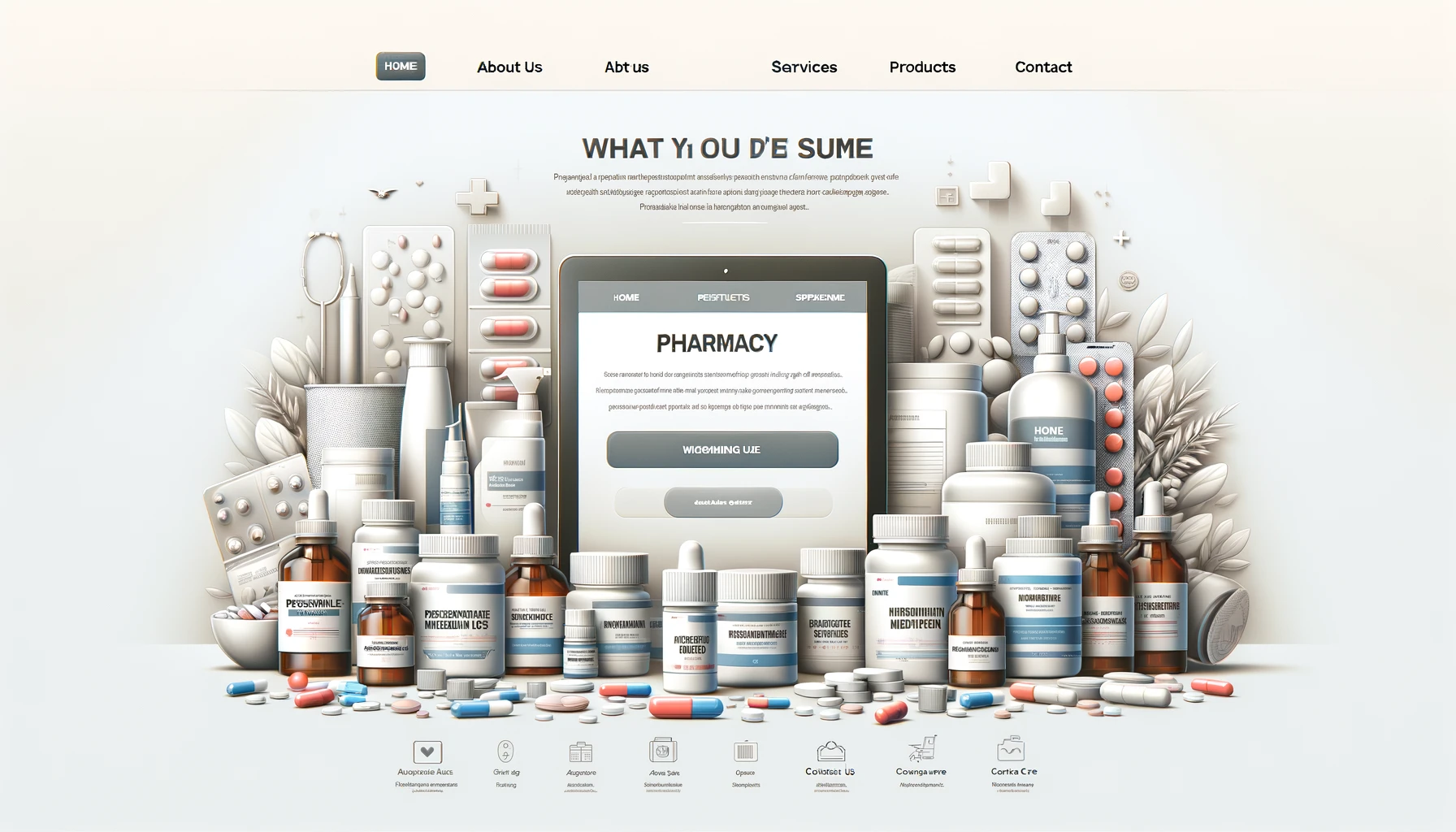In today’s digital age, creating a website for a pharmacy is not just an option, but a necessity to stay competitive and accessible. An effective website for an online pharmacy offers a crucial platform for connecting with customers, providing convenient and discreet access to medicines and health products, without the need to visit a physical store. In addition, it allows pharmacies to expand their reach, improve inventory management, and provide vital information and health advice directly to consumers. In this introduction, we will explore how developing a proper website can transform a traditional pharmacy into a dynamic online point of sale, improving both the customer experience and the operational efficiency of the business.
Tabla de Contenido
- 1 What is a Pharmacy?
- 2 What other names are given to Pharmacies in Latin America?
- 3 What is the importance and benefits of creating a website for a Pharmacy?
- 4 What is the recommended navigation structure for a pharmacy website?
- 5 What should be the functionalities for a Pharmacy’s Online Store?
- 6 What should be considered for the Design and Usability of a Pharmacy Website Catalog?
- 7 Conclusions
- 8 ¡Request an Instant Consulting Session!
- 9 I want an Instant Consulting
- 10 What are the online payment methods in Canada for virtual stores and e-commerce?
- 11 How to sell your products and services internationally with an e-commerce? – Part I
- 12 Do you still not know how Social Networks Commerce works?
What is a Pharmacy?
A pharmacy is an establishment where medicines are dispensed and health-related services are offered under the supervision of licensed professionals, known as pharmacists. Pharmacies play a crucial role in the health care system by providing access to drug treatments, medication information, and counseling to ensure the safe and effective use of medications. In addition to medications, pharmacies often sell health and wellness products, personal care products, and some may also offer clinical services such as vaccinations, blood pressure measurements, and diabetes testing.
Main Functions of a Pharmacy:
- Medication Dispensing: The primary function of a pharmacy is the dispensing of prescription and over-the-counter medications. This includes making sure that medications are delivered in the correct dosage and with proper instructions for safe use.
- Pharmacy Counseling: Pharmacists provide information and advice on how to take medications correctly, possible side effects, and how to handle any potential drug interactions.
- Medication Control: Pharmacies also play an important role in controlling the distribution of certain medications, ensuring that they are dispensed in accordance with current legislation, especially those that require a prescription.
- Health Promotion: Many pharmacies offer health promotion and disease prevention services, including vaccination campaigns, smoking cessation programs, and health education.
- Primary Care Services: Some pharmacies offer primary care services, performing basic diagnostic tests and minor treatments.
- Sale of Health and Wellness Products: In addition to medications, pharmacies typically sell a variety of health-related products, including vitamins, supplements, dermatological products, and basic medical equipment.
The pharmacy, as an access point to health care, is often one of the first points of contact for individuals seeking medical assistance or advice, underscoring its importance in promoting and maintaining public health.
What other names are given to Pharmacies in Latin America?
In Latin America, pharmacies can be known by various names that vary by country and region. Here are some of the most common terms used to refer to pharmacies:
- Botica: A term traditionally used in several Latin American countries to refer to pharmacies. Although less common today, it is still used in rural contexts or in pharmacy names that seek to evoke a sense of tradition and trust.
- Drugstore: In some countries, this term is used interchangeably with pharmacy, although in others it can refer to a type of store that sells a wider range of products, including personal care and health items, but not necessarily medicines.
- On-call or on-call pharmacy: Refers to pharmacies that are open outside of normal business hours, including evenings and weekends, to always ensure access to essential medicines.
- Hospital Pharmacy: Specifies pharmacies located within hospitals, which are responsible for dispensing medicines to inpatients and outpatients, under medical prescription.
- Parapharmacy: In some countries, this term is used for establishments that sell health and wellness products that are not medicines, such as nutritional supplements, personal hygiene products, and cosmetics.
These names reflect the diversity of services and products that these establishments can offer and how local culture and country-specific regulations influence the terminology used in the pharmaceutical sector.
What is the importance and benefits of creating a website for a Pharmacy?
Creating a website for a pharmacy offers multiple benefits for both the business and its customers, becoming an essential tool in today’s digital environment. Here are some of the main advantages of having a website for a pharmacy:
- Increased Accessibility: A website allows customers to access pharmacy services and make purchases of medicines and other health products 24/7 from anywhere. This is especially valuable for people with reduced mobility, chronic patients, or those who live in remote areas.
- Market Expansion: By operating online, a pharmacy can reach a wider audience, transcending the geographic limitations of a physical location. This allows you to attract new customers who might not otherwise be able to visit the pharmacy in person.
- Improved Customer Experience: A well-designed website offers customers a convenient and efficient way to search for products, compare prices, read reviews, and get detailed product information. In addition, functionalities such as online ordering and virtual consultations significantly improve the customer experience.
- Operational Efficiency: Automating orders and managing inventories through a website can improve the pharmacy’s operational efficiency. Online tools help to better manage stock, reduce order errors, and optimize the dispensing process.
- Marketing and Promotion: A website is an effective platform for marketing campaigns and promotions. Pharmacies can use the website to advertise special offers, promote services such as vaccinations or health consultations, and post educational content that attracts and retains customers.
- Data Analysis: The website allows you to collect valuable data on customer behavior, purchasing preferences, and effectiveness of marketing campaigns. This information can be used to make informed decisions about business management and personalization of offerings.
- Improved Customer Service: With a website, pharmacies can offer enhanced customer care services, such as live chat, phone support, and answers to frequently asked questions, which can help resolve concerns and improve customer satisfaction.
- Compliance and Transparency: The website offers a means to ensure that all communication and transactions comply with legal and ethical regulations, providing customers with a safe environment for the purchase of medications.
In short, a website not only helps a pharmacy improve its visibility and accessibility but also strengthens trust and relationship with its customers, offering more personalized and efficient services that respond to the current needs of health consumers.
For a pharmacy website, a clear and efficient navigation structure is critical to providing an optimal user experience and facilitating access to products and services. Here’s a recommended navigation structure for these types of sites:
Beginning:
- Home Page: Presents an overview of the pharmacy, highlighting key services, current promotions, and featured products.
Products:
- Product Categories: Organize products into clearly defined categories, such as Drugs, Vitamins & Supplements, Personal Care Products, Medical Equipment, and Baby Products.
- Subcategories: Within each main category, it offers subcategories for easy searching, such as Over-the-Counter Medications, Prescription Medications, Adult Vitamins, Children’s Vitamins, etc.
Services:
- Pharmacy Consultations: Provides information about services such as online or in-person pharmacy consultations, medication review, and personalized counseling.
- Health Services: Details additional services the pharmacy may offer, such as vaccinations, diagnostic tests (blood pressure, glucose levels), and chronic disease management programs.
Information & Tips:
- Health Blog: Publishes educational articles and tips on health and wellness, chronic disease care, nutrition, exercise, and safe medication use.
- FAQs: Includes an FAQ section that provides answers to the most common questions about medications, online ordering, and pharmacy policies.
Client Area:
- My Account: Allows users to register and access their personal profile where they can manage their data, order history, prescriptions, and subscription settings.
- Shopping Cart: Facilitates access to the shopping cart where users can review and modify their orders before proceeding to checkout.
Special Offers:
- Promotions: Displays current promotions and discounts, potentially organized by product category or seasonal event.
Contact:
- Contact Details: Offers multiple ways to contact the pharmacy, including phone numbers, email address, and direct contact form.
- Live Chat: Provides a live chat system for instant assistance and quick queries.
Store Policies:
- Privacy & Security Policy: Detailed information about how the pharmacy handles personal information and maintains the security of customer data.
- Terms and Conditions: Clarifies the terms of use of the website, including return and order cancellation policies.
Implementing this navigation structure will help ensure that customers can easily find what they’re looking for and access important services seamlessly. Not only does this improve the functionality of the site, but it also increases customer satisfaction and boosts the pharmacy’s operational efficiency.
What should be the functionalities for a Pharmacy’s Online Store?
For a pharmacy online store, with our TecnoCommerce platform, integrating effective and user-oriented functionalities is crucial to facilitate navigation, improve the shopping experience and ensure efficient business management. Here are some key features you should include:
Detailed Product Catalog:
- Complete Descriptions: Provide detailed information for each product, including composition, indications, contraindications, recommended dosage, and potential side effects.
- High-Quality Images: Display clear and professional images of products to help customers easily identify them.
Advanced Search & Filters:
- Powerful Search Engine: Incorporate a search function that allows users to quickly find specific products by name, category, or symptom.
- Dynamic Filters: Provide filters that allow users to refine their search by product type, brand, price range, and ratings.
Prescription Management:
- Uploading and Verifying Prescriptions: Allow users to upload prescriptions digitally for the purchase of prescription medications. Implement a verification system to ensure the authenticity and correctness of recipes.
Custom User Accounts:
- Personalized Profiles: Make it easy for users to create profiles where they can manage their personal data, brief medical history, prescriptions, and purchase history.
Secure Shopping Cart & Checkout:
- Efficient Checkout Process: Design an easy-to-use shopping cart and checkout process that is fast and secure, with multiple payment options including credit cards, PayPal, and other electronic methods.
Automated Interactions and Alerts:
- Medication Reminders: Offer a reminder service for medication taking or prescription refills.
- Stock Notifications: Alert users when a product is back in stock or when there are special promotions.
Virtual Consultations:
- Online Consultation Service: Implement a system where users can book and conduct virtual consultations with pharmacists to discuss questions about medications or health conditions.
Loyalty Programs & Promotions:
- Rewards Program: Establish a points or rewards program that incentivizes customers to make repeat purchases.
Customer Support:
- Multi-Channel Support: Provide various forms of customer support, including live chat, phone line, and email support.
Health & Educational Information:
- Health Resources: Offer a blog or news section with educational articles on health and wellness, new medical research, and healthy lifestyle tips.
Implementing these functionalities not only improves the accessibility and effectiveness of a pharmacy’s online store, but also strengthens customer trust, ensuring that they receive a complete and secure shopping experience.
What should be considered for the Design and Usability of a Pharmacy Website Catalog?
The design and usability of a website catalog for a pharmacy is critical to ensuring that customers have a smooth and satisfying experience while browsing and purchasing products. Here are some key things to consider:
Clarity and Simplicity in Design:
- Clean Design: Use a clear layout with no visual clutter that makes it easy for users to find what they need quickly. Using white space, legible fonts, and colors consistent with the brand can help improve clarity.
- High-Quality Images: Make sure all product images are clear and professional, displaying the product in a way that customers can see important details.
Intuitive Navigation:
- Easy-to-Navigate Menus: Menus should be intuitive and easy to understand, with logically organized categories and subcategories. Consider including a prominent search bar with autocomplete capabilities.
- Categorization by Use or Condition: Organize products not only by type, but also by their use or the health condition they treat, thus making it easier for customers to find what they need.
Accessibility:
- Responsive Design: The site should be fully functional on all devices, especially mobile phones, given that many users will access the site through these devices.
- Accessibility for All Users: Implements web accessibility standards to ensure that people with disabilities can also navigate the site easily.
Detailed Product Information:
- Comprehensive Descriptions: Each product should have a detailed description, including information on dosages, active ingredients, warnings, and any other relevant information.
- Instructions for Use: Provides clear instructions on how to use the products, especially for prescription medications.
Simplified Purchase Process:
- Fast & Secure Check-out: Minimizes the number of steps required to complete a purchase and ensures that the process is secure and transparent.
- Varied Payment Options: Offers multiple payment options to accommodate the preferences of different users.
Customer Support:
- Easy Access to Support: Includes easy access to support options like live chat, phone help, and email, making sure customers can get help when they need it.
Interactivity and Personalization:
- Personalized Recommendations: Uses algorithms to offer personalized recommendations based on the user’s purchase and browsing history.
- Alerts & Reminders: Implement features to remind users when it’s time to reorder medications that are purchased regularly.
Security & Privacy:
- Data Protection: Ensures that all transactions and user data are protected with appropriate encryption technology and comply with privacy regulations, such as GDPR or HIPAA if applicable.
By considering these elements, you will be able to create an online catalog that is not only user-friendly and aesthetically pleasing, but also functional and secure, thus improving the customer experience and boosting the operational efficiency of the online pharmacy.
Conclusions
Creating a website for a pharmacy, with our TecnoCommerce platform, represents a crucial opportunity to expand the reach of the business, improve the accessibility of pharmaceutical services and products, and offer a superior customer experience. A well-designed website not only makes it easy for customers to access medicines and health products from the comfort of their own home, but it also serves as an educational platform where they can gain valuable information on various health topics.
By integrating advanced functionalities such as advanced search, intuitive categorization, and simplified purchasing processes, a pharmacy website can significantly improve operational efficiency and customer satisfaction. Not only does this translate into an improved user experience, but it also increases sales and strengthens customer loyalty.
In addition, the website allows the pharmacy to implement effective digital marketing strategies that attract new customers and keep existing ones. The ability to analyze user data also offers valuable insights that can be used to optimize product offerings and personalize customer interactions.
Finally, it is critical that the website complies with all privacy and security regulations to protect customers’ sensitive information, strengthening their trust in the pharmacy as a safe and reliable healthcare provider.
In short, investing in a robust and well-designed website is essential for any pharmacy looking to thrive in the modern digital environment, improving not only its efficiency and profitability but also its ability to meet and exceed its customers’ expectations in healthcare.
Finally, if you are in the Pharmacy or Drugstore business, and you are looking to create a Website for a successful Online Pharmacy, contact us now!






